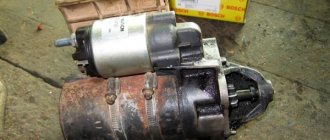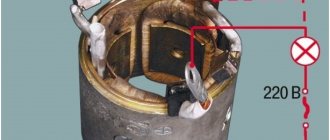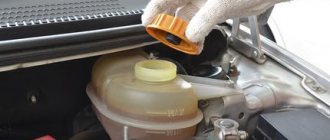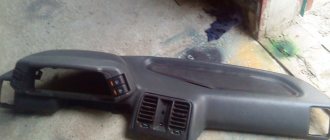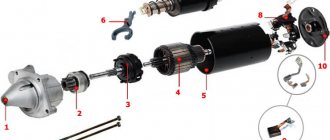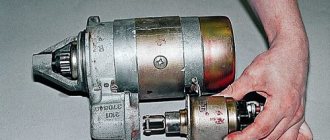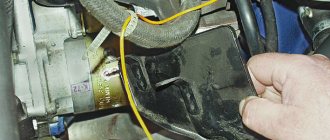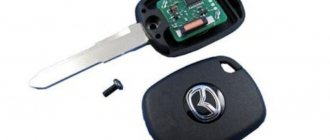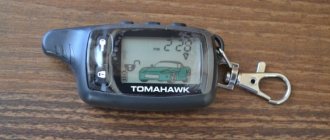During the operation of a car, problems with the starter quite often arise. Moreover, even if the battery is charged and power comes to the starter after turning the key in the ignition, the device still does not work and the engine does not start.
In such a situation, there are only two ways to start the engine:
- starting the engine “from the pusher”;
- attempt to close the starter directly;
Although the second method is less common, in some cases this method is more “convenient”. The main thing is to know how to bridge the starter correctly to start the power unit. Read more in our article.
Other reasons why the car won't start
The role of the starter in the engine is to spin the crankshaft. It creates the necessary torque and compresses the mixture of fuel and air.
Due to the fact that the starting device does not act alone, but in conjunction with other components and assemblies, the following factors may be the source of problems:
- insufficient voltage in the battery;
- complete loss of battery charge;
- destruction of wiring or contacts;
- the appearance of malfunctions in the ignition switch;
- oil with non-standard characteristics;
- atmospheric corrosion of some parts of the conductive circuit.
Main signs of starter malfunction
Despite the fact that the starter is a fairly reliable device, it can also break. Some breakdowns may have symptoms identical to other faults, but there is still something in common when the electric motor malfunctions.
The main symptoms of starter malfunctions:
The solenoid relay does not click (does not operate) and the armature does not rotate.
- Battery discharge (complete or partial) or failure;
- Oxidation of battery terminals and tips connected to it;
- The terminals or tips connected to both the starter itself and the battery have come loose;
- Lack of contact on the terminal bolts, caused by a break in the wires connecting the ignition switch and starter;
- Short circuit, break or breakdown of the solenoid relay windings to ground.
When the electric motor starts and the solenoid relay is operational, the armature rotates slowly or does not rotate at all.
- The contact on the terminal bolts of the solenoid relay is broken;
- High wear of brushes or their jamming;
- Burning or overheating of the collector plates;
- Breakdown of the stator winding caused by insulation failure or interturn short circuit;
- Damage to the insulating layer of the positive brush holder;
- Short circuit of collector plates caused by insulation failure;
The armature of a running starter rotates, but the crankshaft does not spin.
- Overrunning clutch slipping;
- Mechanical damage to the freewheel (buffer spring, underwater ring);
- The starter drive fork is flying out or damaged;
- Difficulty in moving the drive along the thread on the anchor shaft.
After starting the engine, the starter continues to operate.
- Drive fork jamming;
- Damage to the ignition switch spring;
- Jamming of the solenoid relay or starter drive contacts on the anchor shaft;
- Damage or stretching of the springs that return the solenoid relay or overrunning clutch;
- Solenoid relay jammed;
- Warping of the electromagnetic motor caused by unscrewing its fastenings to the internal combustion engine.
Increased noise when the starter is running.
- Increased wear of individual parts of the armature (necks and bushings);
- Violation of the integrity of the starter housing at the drive location;
- Mechanical damage to the teeth of the flywheel or bendix;
- Insufficiently tightened motor mounts;
- Contact of the armature with the pole during rotation due to the weakened fastening of the latter inside the unit.
Starter diagnostic methods
Certain problems with the starter allow it to function while the engine is running. As for spinning up a massive flywheel on the first try, this turns out to be impossible.
However, you should not play the lottery. If the engine starts successfully, you should immediately deliver the starter to professional auto electricians so that they can diagnose the unit and identify the real cause of its breakdown.
Cases in which the problem can be solved on site
If the starter does not start, there are several ways to start the car.
- short-circuit the starter contacts using a screwdriver;
- Connect the starter directly to the battery.
In an automobile system, the starter performs a separate role - it turns the crankshaft to create the appropriate torque and compress the fuel-air mixture. Naturally, the starter works in conjunction with other electrical components and systems. Therefore, different types of faults can occur:
- lack of voltage in the on-board network;
- low battery;
- damaged wiring;
- problem with the ignition switch;
- mismatch of oil viscosity in the crankcase;
- loose contacts.
If the starter fails, then in most cases the traction relay fails, the coil winding is burnt out, the bendix is slipping or the screwdriver is loose.
Some starter malfunctions allow the starter to operate normally while the engine is running. But he cannot spin the heavy flywheel the first time. In any case, after a successful start, professional diagnostics of the starter is necessary to determine the true cause of the malfunction.
Starter failure can be caused by the following reasons:
- faulty starter relay;
- worn bendix;
- malfunction of the solenoid relay;
- combustion of internal components.
Direct closure of the starter
To close the starter directly, it is necessary to connect it to the battery or through contacts. Both of these methods are considered reliable, however, provided that the anchor remains intact.
How to check the solenoid relay
To check the starter solenoid relay, you need to connect the positive battery terminal to it , and the negative terminal to the device body . When the relay is working properly, the Bendix gear will move out with a characteristic click.
Checking the Solenoid Relay Using a Battery
The gear may not extend due to:
- burnt retractor contacts;
- jammed anchor;
- burnout of the starter winding or relay.
Shorting terminals with a metal object
If a fault is detected in the traction relay, it is necessary to use the direct closure method using an iron rod of suitable length. Most often in a garage this becomes
- screwdriver;
- wrench;
- improvised metal pin.
The fact that there are problems with the retractor can be guessed by the specific clicking sound when turning the key in the lock. At this moment, the starter is unable to start rotating the crankshaft, since the bendix teeth simply do not engage with the flywheel crown.
How to close the starter
To close the starter, you need to connect the starter power contacts with a metal part of a suitable tool. This will allow voltage to be applied to the winding directly. To do this, you need an assistant who must turn the key in the lock to the “start” position.
In general, the process looks like this:
- the car is put on the “handbrake”, the manual transmission is switched to neutral or the P mode is switched on “automatic”;
- The contact plate is removed from the starter, after which the contacts need to be short-circuited with the tip.
In this case, it is important that a current conductor of suitable length and cross-section be used as a jumper. Typically, a screwdriver with a thick shaft or a wrench with an insulated handle is used for these purposes.
To understand how to close the starter with a screwdriver, you need to pay attention to the following:
- you need to close the contacts of the power line precisely on the solenoid relay.
- All actions should be performed carefully and carefully, without touching other elements under the hood;
- Do not touch the starter housing with a screwdriver, etc.
- after starting the engine, the screwdriver must be removed;
In this case, closing two power contacts on the solenoid relay with a screwdriver is similar to closing them from the inside with the relay armature. In fact, the operation of a retractor starter motor for connecting the electric motor is simulated. If the ignition is turned on, the starter will start working with such a short circuit and the engine will start.
Please note that when the contacts are closed there will be sparks, since the starter connection is direct. Another disadvantage of the method is that not all cars have direct access to the starter (it is impossible to close the contacts on the solenoid relay). After the engine starts, the screwdriver will need to be removed from the contacts, after which the starter will turn off.
If we take a closer look at the question of how to connect the starter directly, pay attention to the following points:
You need to find the control (pin that looks like a petal). Other contacts (one with potential +12 has a thick wire). Another contact is an electric motor contact. You need to close the control terminal (usually closed with a rubber cap) and the contact tab (usually closed with a plastic plug).
A handy alternative to a traction relay
If you close the starter terminals, you will be able to direct the current directly to the electrical windings. In this case, a screwdriver or other improvised device will perform the function of a traction relay.
It is very important to put the car on the handbrake and at neutral speed before carrying out such manipulations, otherwise severe injury or death of the mechanic is likely due to the vehicle getting out of control.
Recommendations
Systematic starting directly can lead to malfunctions in the vehicle wiring. This type of connection can be used one time. To correctly close a knot directly, you should follow several rules:
- Select a metal product with a large cross-section. This will prevent the part from heating up and causing a burn.
- It is necessary to close the nuts, not the threaded surfaces. Violating this rule will damage the threaded connection.
- When connecting, do not touch other parts. The mass of a vehicle is its body. Connecting pads and other parts will result in a short circuit.
- Turn off the power immediately after starting the power plant. Untimely shutdown will cause the drive gear (Bendix) to break.
Taking into account these recommendations, you will be able to correctly close the electric starter with a screwdriver or other object.
Safety rules for closing the starter with a screwdriver
You should also ensure that the tool you use is equipped with a carefully insulated handle and that its metal part is not thin or flexible. It is automobile screwdrivers that fully meet the listed criteria.
If the decision was made to use a pry bar or wrench, then it is strictly forbidden to begin work unless a thick layer of insulating tape has first been applied to the place of the hand grip. It is strictly forbidden to short-circuit terminals B and S, M and B.
conclusions
Let's look at diagram 1 again. If the key is not turned to the Start label, terminal S is “hanging in the air.” This can be done for any car, even if the circuit has an additional relay. This means that it will not be necessary to disconnect the standard wire from terminal S... And in the case of a VAZ, the disconnection is carried out in order to gain access to the terminal.
We removed the filter, disconnected the plug, and tried to close it...
If the engine filter cannot be removed or access is blocked by the battery, we do it differently - we use only the crank.
It is better to close the contacts not with a screwdriver, but with any wrench (see photo). It is desirable that the handle be insulated.
12 Volt voltage is not dangerous, but errors can result in blown fuses. Good luck.
For those who do not understand everything: the filter must be removed from the mounts, but not from the “corrugation”. The filter housing is placed on the battery.
Starter short circuits on VAZ cars
Owners of VAZ models should take into account the following nuance. On the nine, ten and 14th models, to bridge the starter with a screwdriver, you will have to do the following:
- remove the air filter;
- separate the chip that is laid on the contact group.
After successfully starting the engine, the listed components are reassembled.
No second attempt allowed
A significant disadvantage of this method of restoring the starter’s functionality is the real danger of burning the car’s ignition coil. It is for this reason that it is extremely undesirable to try to perform this combination a second time.
It's better to limit yourself to one attempt. If it is not successful, then the source of the problems must be carefully looked for in other systems and units.
Method for VAZ 2107
This machine has a starter that can be started using a special handle. To do this, insert it into the provided hole in the body and by quickly rotating the car the car should start.
In the end, I would like to add that all the described methods should be used when, for various reasons, it is not possible to get professional help or tow the car to a repair shop. Therefore, we strongly recommend that you contact professionals, and before solving the problem yourself, carefully study the problem that has arisen and its solution in order to further avoid negative consequences. Good luck on the roads!
Danger of screwdriver sticking to starter terminals
You should also be prepared for another extremely unpleasant scenario. At the points where the iron rod comes into contact with the terminals, no matter what the current strength in the vehicle network, a current of up to fifty amperes is created.
For this reason, the screwdriver pin is quite capable of both sticking to the contacts and striking sharply into the palm. In such a case, it is necessary to reset the negative terminal using an open-end wrench without unnecessary emotions.
Scheme, theory and practice
Let's look at the wiring diagram for each electric starter. Contact B is constantly energized.
Starter and its external circuits
In the diagram we see three “positive” contacts and one negative (8), which is always connected to the body. Which should be shorted:
- Before shorting the starter, you need to find the S terminal. It is often made in the shape of a petal;
- How to distinguish between contacts B and M: the first will have the potential “+12”;
- Close contact B with terminal S. This is done briefly and with the “neutral” switched on;
- Do not short circuit terminals M and B.
Let's move from theory to practice. In the VAZ-2114 everything looks simple.
Terminal B here is covered with a rubber band, and tab S is in contact with the terminal in plastic. Before “closing” it is necessary to remove the plastic plug.
Closing the starter contact using a screwdriver
Make sure that the metal of the screwdriver does not touch the relay body when closing it. Failure to comply with this requirement will result in a short circuit between the “+” and “ground” contacts. (dangerous). All work must be carried out with the ignition on.
- B - bold, “thick” wire;
- M - engine;
- S - Start.
Connecting the starter directly to the battery
In order to make a direct connection between the starter and the battery, it will be necessary
- a piece of copper wire;
- alligator clips;
- flat configuration plug.
The listed devices become components of a carrier that allows you to start the motor. Such a self-made accessory should be connected to a conductive cable going to the starter. It is equipped with a connector to which the carrier should be connected.
Our advice
- First of all, do not allow short circuit or any other accidental short circuit of power contacts that are different from the control terminal and spade contact.
- Taking into account that direct access to the starter is often provided at the bottom, you must be prepared for the mandatory removal of standard or other protection.
- On many vehicles, the control terminal is similar to a threaded outlet.
- At the end of starting a car engine, you need to check the fuses separately, since it happens that they burn out due to errors.
- Since the traction voltage is 30-50A and higher, the connection points may stick.
- Drivers of older cars in which the switch does not control the voltage supply to the coil should be aware that when the starter is shorted, the coil may stop working.
What to do if closing the starter did not help
- The car is placed at neutral speed;
- the ignition is turned on;
- The crocodile starts on the positive terminal of the on-board battery.
If there are no other problems or doubtful aspects in the design of the machine, the starter should turn on. When the engine can be started safely, you must immediately reset the terminal from the battery.
The homemade carrier must be torn out from the place of fixation. The removed plug is returned to its original position.
The listed manipulations will not cause great difficulties, but in no case should you relax and act carelessly. Otherwise, there is an absolute danger of getting a serious burn or causing a short circuit.
Some information about the ignition switch device
Lada Priora cars use anti-theft locks that block the next start of the starter and connect the key to the standard anti-theft system. The device is located directly under the steering wheel in a special way (four screws with tear-off caps that prevent unscrewing) and is fixed to the steering column.
The engine is started using a key that is inserted into the lock cylinder.
The device is powered by a battery, and a special relay marked “K4” is responsible for ensuring proper protection of the electrical circuit. The starter locking is achieved by a locking rod that is retracted and prevents the key from being removed in all its positions except the zero stage (position “0”). With one key position, only electrical circuits are activated. In a different condition they are different. For example, at the first mark, some on-board equipment is activated (windshield wipers, power windows, dashboard indicators, etc.), and the next time you turn the key in the ignition switch, an additional power circuit is activated, and the engine starts.
Other engine starting options
The car enthusiast also has the following methods of starting the engine that do not require the participation of a starter:
- towing method;
- by pushing back or forward.
We must not lose sight of the fact that both of these methods are completely inapplicable for cars equipped with automatic transmission. Due to the specifics of this gearbox, such methods of solving the problem can lead to extremely unpleasant consequences.
We will open Priora in Moscow and Moscow Region
Promptly, carefully and professionally, experienced technicians from the LOCKSERVICE emergency service will provide assistance with the problem of how to open a Priora without a key. We have been working in the emergency car opening market for more than 12 years and know how to open a Lada Priora or open a car of any other brand without any damage. In what other situations may you need to call LOCKSERVICE specialists?
- The doors locked spontaneously, the keys remained in the cabin;
- The battery is dead;
- The lock cylinders are faulty or dirty;
- Locks froze in the cold due to moisture that accumulated on the seals;
- The key is lost or broken;
- The alarm went off from the inside and the driver was locked inside the car;
- The car stalled in a traffic jam, the central locking was blocked;
- The key fob is discharged, the car does not open;
- The lock in the glove compartment is broken;
- The trunk does not open;
- The key broke in half in the door keyhole;
- The gas tank cap does not come off;
- The lock of the tank filler cap is broken.
There are many ways to open any car without a key. We offer you those that can be used in any conditions, while remembering that the best way to open a car is to entrust it to professionals.
Rules for pushing and towing a car
Pushing is especially popular among car enthusiasts. For its successful implementation, the participation of several healthy and strong men is necessary.
If the decision was made to tow, then this will require a very strong special cable. It clings to the towbar of the tractor, after which both begin to move. If there are no problems in the ignition system or engine components and assemblies, then it is highly likely to start.
Towing safety
- The towing vehicle should not start moving impulsively. The start should be extremely smooth and slow. Otherwise, there is a high probability of the bumper, towbar, or cable breaking off.
- The towed vehicle should not suddenly stop moving or simply reduce speed while the towing vehicle retains kinetic energy. Otherwise, the cable may become over-tensioned and break, which could result in the windshield breaking and fatal injury to the driver of the towed vehicle.
- After disconnecting the cable, under no circumstances should you turn off the engine, because then it may simply not start.
How to push a car
The widespread “pusher” is based on the rigid support of the hands of several men in the trunk or hood of a car. In this case, the gearbox lever should be set to
- second;
- fourth;
- or reverse gear.
To successfully implement such a plan, the car must be accelerated as much as possible. That is why it is advisable to try to start it with a pusher on a gentle slope. It is strictly forbidden to push the car in a place sandwiched by walls, garages and other barriers. This is a very dangerous type of launch, fraught with disability and death of assistants.
We start the car without interfering with the engine compartment
If the car has a small mass, and there are assistants nearby and space that allows unhindered acceleration, then you should resort to the method popularly referred to as “push”. To do this, the driver needs to turn the ignition key, then, with sufficient acceleration of about 10-20 km, depress the clutch and engage second gear, then confidently, but slowly, depress the pedal, as soon as the car starts, it is recommended to engage neutral gear and allow the engine to warm up to operating temperature.
Please note that this method only works on cars with a manual transmission. In winter, it is recommended to start in third gear to avoid wheel slipping.
There is also a way for cases where there are no assistants or the necessary space for maneuver.
Important! Only suitable for vehicles with front wheel drive and a working handbrake.
We place a jack under one of the front wheels, after lifting, wrap a cable or any other similar rope around it and with a sharp movement try to turn the wheel in the direction of travel. Just remember to turn on the ignition and second gear first. If the engine starts successfully, put the car in neutral and lower the car; if the attempt fails, repeat the action.
It is worth mentioning the towing method; as a rule, car owners are always ready to help a fellow driver in a difficult situation, so do not hesitate to ask for help. The principle of operation is the same as with a pusher, just be careful when the car starts up not to hit the car towing you.
